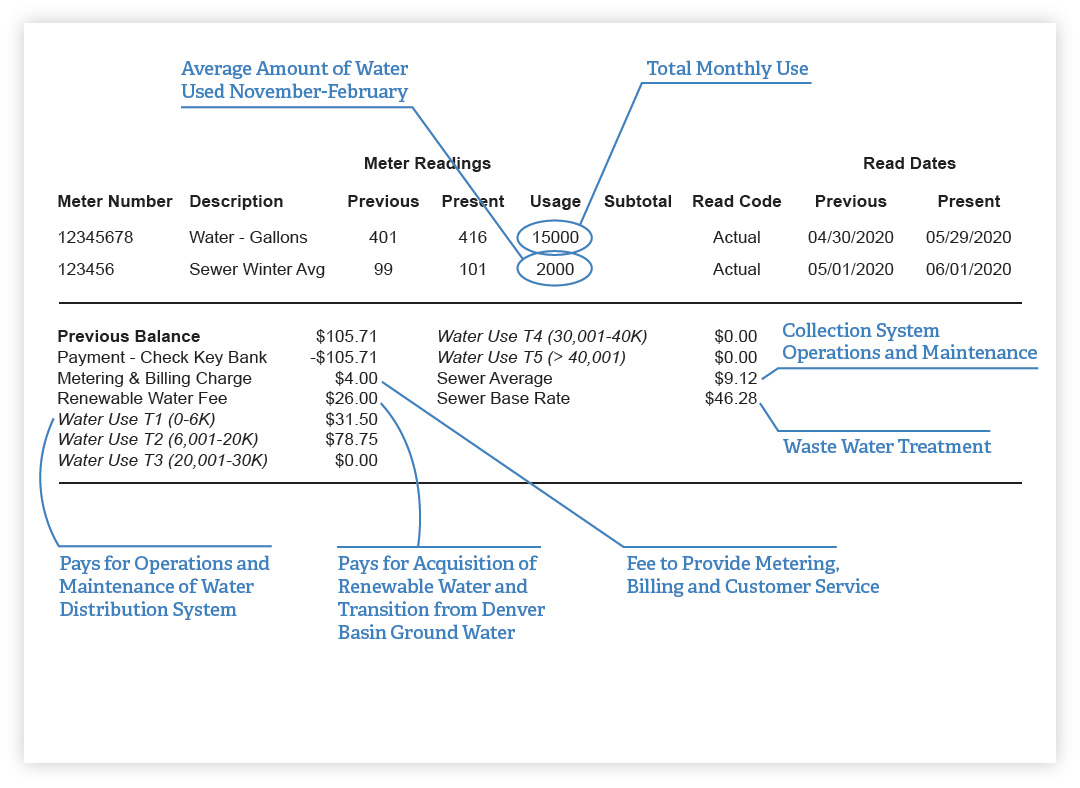Triview Newsletter – July 2020
Water continues to be a hot topic of discussion in the District, so we wanted to address a few of the more common questions we are getting about water rates, usage, how residents are billed, and how to better understand the charges on your bill.
The Water Bill

Tiered Water Rates
In the Triview Metro District, residents are billed for water in tiered rates according to their usage – as you use more water, the rate charged for each new tier increases slightly. During the summer months, when the sprinklers are generally running three days a week, residents will see their highest water bills. The table below shows the dollar rate per usage.

Why You Should Consider a New Water Meter
As we’ve shared in previous newsletters, the District is upgrading water meters in our residents’ homes this year. There is no cost to the homeowner and the benefits of the new technology are substantial. One of our District board members, Marco Fiorito, has been using the new meter for several months now.
All water meters will be replaced over the next few years, so If you’re interested in replacing your water meter now, please email us: info@triviewmetro.com. The process is easy and there is no cost to the homeowner.
- A trained District staff member (wearing a mask if requested) will replace the meter in your home.
- It will take approximately 30 minutes to change out your meter.
- Homeowners will need to be present because most water meters are located in basements.
- Homeowners will be able to schedule their appointment, and some evening/weekend hours will be available.
- There is no cost to the homeowners.
What Marco Fiorito Says About the Meter:
“I love my new meter, which was installed in April (2020). The ability to track water in 15-minute increments is incredibly helpful. After some time, I was able to see that I was dumping more than 200 gallons of water twice a day, which told me I had a leak somewhere. And sure enough my drip line had four different leaks. I modified my watering schedule for my lawn, and I’m now about 20% under my nominal historical use, which has saved me quite a bit of money. I want other residents to know that you have the ability to see water use every minute, hour, day and month. You can also set alerts for excessive water use. The app is easy to use, convenient and has saved me money and water, and it’s free.”
Detecting Leaks
If your water bill is higher than you expect, you may have an undetected leak inside or outside of your home. Sprinklers can leak at several spots – the sprinkler heads, the drip line or even the sprinkler line itself. The system can leak even if you have the system turned off at the control box as long as the valve is open allowing water to the system.
To determine if your sprinkler system is leaking, first make sure there is no water turned on in your home. Then, look at your water meter, which is usually in a utility room. Open the lid on the top of the meter and look for a small snowflake-type dial on the face of the transponder. If this dial is moving, that indicates a leak somewhere in your home.
If you turn off the sprinkler main valve and the dial stops, that is a sign of a leak in the sprinkler system. You may also find a soggy or mushy area in your yard which would indicate excess water. Alternatively, if you see brown spots, then it could be that nozzles aren’t performing the way they should, and that area is not getting adequate water.
If you suspect you have an irrigation leak, contact a qualified irrigation specialist to determine where the leak is originating and to fix the issue as soon as possible.
Water Facts
- A dripping faucet can waste more than 1,000 gallons of water per year.
- Collectively, almost 60% of all indoor water use occurs in bathrooms (toilets, showers, baths, sinks).
- A single broken sprinkler head can waste up to 25,000 gallons of water over the course of a watering season.
- Low-flow shower heads can save up to three gallons of water per minute.
- Each American uses about 88 gallons of water per day.
- Turning off the tap while brushing your teeth can save 8 gallons of water per day.
- As much as 50 percent of the water we use outdoors is lost due to wind, evaporation, and runoff caused by inefficient irrigation methods and systems.
Data Courtesy of Allstate and the U.S. EPA
Shop Local!
Colorado Gov. Jared Polis is allowing restaurants to open for limited-capacity indoor and outdoor dining, and we encourage you to visit our many Monument restaurants. Also, keep shopping locally when possible as the District receives a 1.5% sales tax share-back from the Town of Monument for retail businesses along Baptist Road and Jackson Creek Parkway. These taxes pay for street maintenance, including street overlays and snow removal, parks and open space maintenance, and the operation of the storm water facilities.
